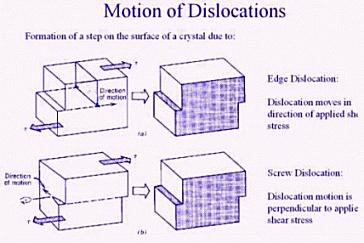
DISLOCATION, EDGE, POINT, SCREW, PLANE Dislocation is the most important mechanism by which ductile deformation is brought about. The two basic types of dislocations are the edge dislocation and the screw dislocation. An edge dislocation moves in the direction of applied shear stress. It occurs along the slip plane. It is orthogonal to the slip vector or Burger's vector. A slip plane is the one which has highest atomic density along it. The movement of dislocation requires very small amount of shear stress than the theoretical shear stress. A characteristic feature of the dislocation is that slip need not occur along a plane across an entire crystal but slip can occur ia a part of the plane. The lattice arrangement is distorted only near the boundary of the slip. At other places, it remains unaltered. While the dislocation moves forward, it leaves behind an undisturbed lattice. In contrast, a screw dislocation moves in a direction normal to the applied stress. DISLOCATION, JOG, NETWORK, PARTIAL
|